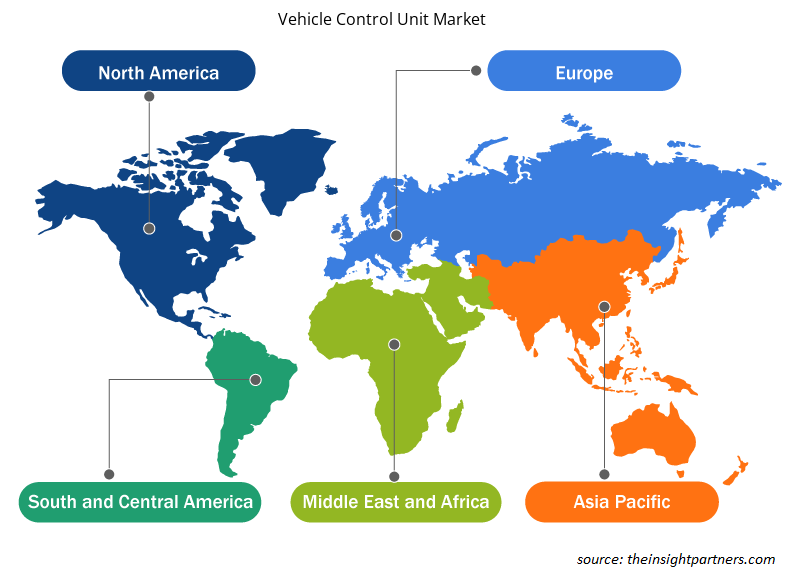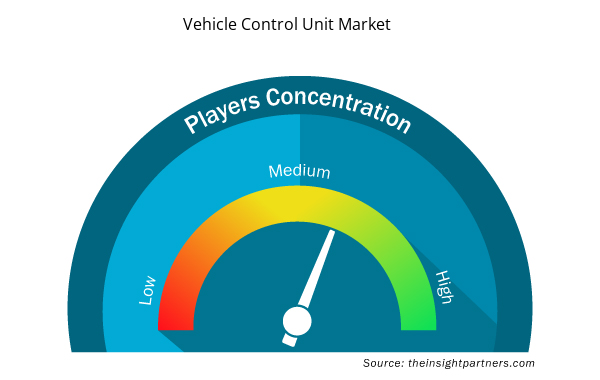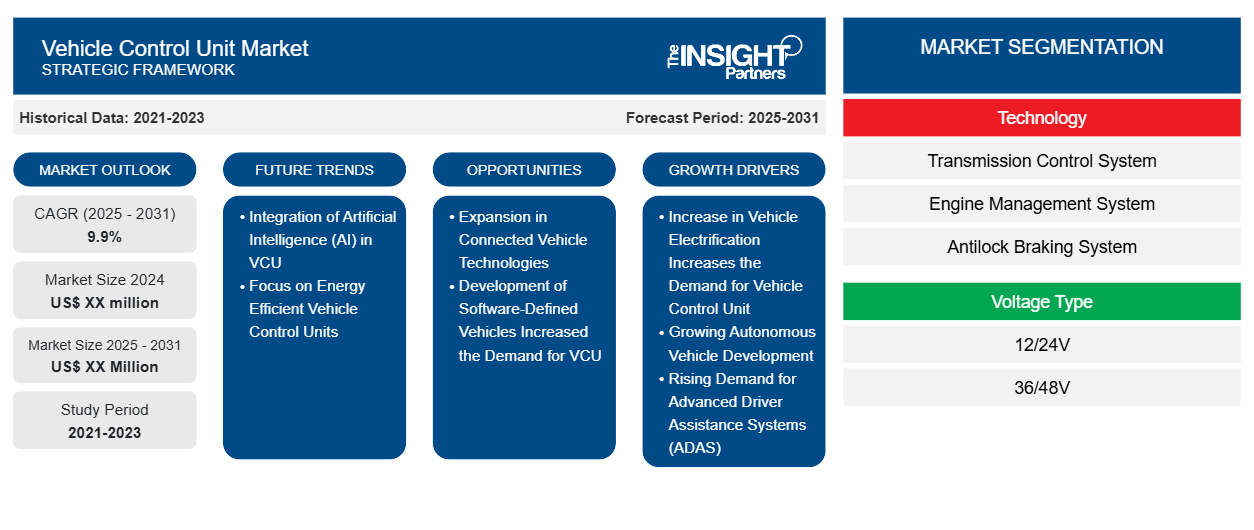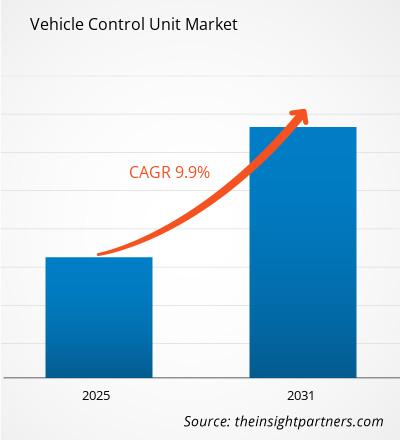Se espera que el mercado de unidades de control de vehículos registre una CAGR del 9,9 % entre 2023 y 2031, con un tamaño de mercado que se expandirá de US$ XX millones en 2023 a US$ XX millones en 2031.
El informe está segmentado por tecnología (sistema de control de transmisión, sistema de gestión del motor, sistema de frenos antibloqueo, sistema de control de climatización, sistema de dirección asistida, otros); tipo de voltaje (12/24 V, 36/48 V); tipo de propulsión (VEB, VHE, VPH, motor de combustión interna (ICE)); tipo de vehículo (vehículo comercial, automóvil de pasajeros). El análisis global se desglosa aún más a nivel regional y por países principales. El informe ofrece el valor en USD para el análisis y los segmentos anteriores.
Propósito del Informe
El informe Vehicle Control Unit Market de The Insight Partners tiene como objetivo describir el panorama actual y el crecimiento futuro, los principales factores impulsores, los desafíos y las oportunidades. Esto proporcionará información a diversas partes interesadas del negocio, como:
- Proveedores/fabricantes de tecnología: Para comprender la dinámica cambiante del mercado y conocer las oportunidades potenciales de crecimiento, lo que les permitirá tomar decisiones estratégicas informadas.
- Inversionistas: Realizar un análisis exhaustivo de tendencias sobre la tasa de crecimiento del mercado, las proyecciones financieras del mercado y las oportunidades que existen en toda la cadena de valor.
- Órganos reguladores: Regular las políticas y vigilar las actividades del mercado con el objetivo de minimizar los abusos, preservar la confianza de los inversores y defender la integridad y la estabilidad del mercado.
Segmentación del mercado de unidades de control de vehículos
Tecnología
- Sistema de control de transmisión
- Sistema de gestión del motor
- Sistema de frenos antibloqueo
- Sistema de control climático
- Sistema de dirección asistida
- Otros
Tipo de voltaje
- 12/24 V
- 36/48 V
Tipo de propulsión
- VEB
- Vehículo eléctrico híbrido (HEV)
- Vehículo híbrido enchufable (PHEV)
- Motor de combustión interna
Tipo de vehículo
- Automóviles de pasajeros
- Vehículos comerciales ligeros
- Vehículo comercial pesado
Tipo de vehículo
- Automóviles de pasajeros
- Vehículos comerciales ligeros
- Vehículo comercial pesado
Personalice este informe según sus necesidades
Obtendrá personalización en cualquier informe, sin cargo, incluidas partes de este informe o análisis a nivel de país, paquete de datos de Excel, así como también grandes ofertas y descuentos para empresas emergentes y universidades.
- Obtenga las principales tendencias clave del mercado de este informe.Esta muestra GRATUITA incluirá análisis de datos, desde tendencias del mercado hasta estimaciones y pronósticos.
Factores impulsores del crecimiento del mercado de unidades de control de vehículos
- El aumento de la electrificación de los vehículos aumenta la demanda de unidades de control de vehículos: la creciente electrificación de los vehículos es un factor de crecimiento importante para el mercado de las unidades de control de vehículos. Las unidades de control de vehículos tienen un papel fundamental en la gestión de los sistemas de batería, control del motor y eficiencia energética de los vehículos eléctricos. Como la electrificación es la vía principal para los futuros fabricantes, su demanda aumentará hasta alcanzar niveles muy avanzados de unidades de control de vehículos equipadas con algoritmos y funcionalidades complejos.
- Creciente desarrollo de vehículos autónomos: los avances tecnológicos en el desarrollo de vehículos autónomos han contribuido enormemente al crecimiento de las unidades de control de vehículos. Después de todo, la integración de las unidades de control de vehículos es necesaria para procesar datos de una gran cantidad de sensores, de modo que sea posible una comunicación ininterrumpida entre los sistemas del vehículo. En consecuencia, este segmento seguirá avanzando a medida que los automóviles se vuelvan aún más autónomos en el futuro.
- Demanda creciente de sistemas avanzados de asistencia al conductor (ADAS): La tendencia de adopción de funcionalidades ADAS en los vehículos aumenta la demanda de VCU. Las VCU son necesarias para centralizar y controlar la amplia gama de funcionalidades ADAS, como la asistencia para mantenerse en el carril, el control de crucero adaptativo y los sistemas de prevención de colisiones. El aumento de las normas de seguridad y la necesidad de equipar funciones de seguridad mejoradas en función de la demanda de los consumidores impulsan el mercado de las VCU.
Tendencias futuras del mercado de unidades de control de vehículos
- Integración de inteligencia artificial (IA) en las unidades de control de vehículos: esta tendencia de integración de la IA en las unidades de control de vehículos está aumentando, lo que ayuda a tomar decisiones más inteligentes y a mejorar la eficiencia. Los algoritmos de IA pueden procesar enormes cantidades de datos procedentes de los sensores de los vehículos en tiempo real, lo que mejora el rendimiento, la seguridad y la experiencia del usuario. Esto está haciendo que los fabricantes de unidades de control de vehículos innoven e incorporen capacidades de IA en sus productos para seguir siendo competitivos.
- Centrarse en las unidades de control de vehículos energéticamente eficientes: la unidad de control de vehículos energéticamente eficiente será el camino a seguir en función del impulso general hacia la sostenibilidad en todo el mundo. Los fabricantes se centrarán en una unidad de control de vehículos que optimice el consumo de energía y la eficiencia general del vehículo. Estará en total sintonía con el objetivo de la industria automotriz de reducir las emisiones en los vehículos, especialmente los vehículos eléctricos e híbridos.
Oportunidades de mercado para unidades de control de vehículos
- Expansión de las tecnologías de vehículos conectados: las tecnologías de vehículos conectados han generado grandes oportunidades en el mercado de las unidades de control de video. Cuantos más vehículos se conectan a Internet, a dispositivos, etc., más se conectan las unidades de control de video, por lo que es necesario modificarlas en consecuencia. Con la creciente demanda de V2X, surge una oportunidad para construir unidades avanzadas con un intercambio de datos eficiente y una mejora generalizada del sistema del vehículo.
- El desarrollo de vehículos definidos por software aumentó la demanda de unidades de control de vehículos: esto es una innovación en las unidades de control de vehículos, ya que abre nuevas posibilidades. El mismo software se puede actualizar para mejorar la funcionalidad y el rendimiento sin alterar el hardware. Abre espacio para la innovación y el desarrollo de unidades de control versátiles y adaptables en el mercado, que se pueden actualizar fácilmente para adaptarse a los requisitos de los clientes y la tecnología.
Perspectivas regionales del mercado de unidades de control de vehículos
Los analistas de Insight Partners explicaron en detalle las tendencias y los factores regionales que influyen en el mercado de unidades de control de vehículos durante el período de pronóstico. Esta sección también analiza los segmentos y la geografía del mercado de unidades de control de vehículos en América del Norte, Europa, Asia Pacífico, Oriente Medio y África, y América del Sur y Central.

- Obtenga los datos regionales específicos para el mercado de unidades de control de vehículos
Alcance del informe de mercado de la unidad de control del vehículo
| Atributo del informe | Detalles |
|---|---|
| Tamaño del mercado en 2023 | XX millones de dólares estadounidenses |
| Tamaño del mercado en 2031 | US$ XX millones |
| CAGR global (2023 - 2031) | 9,9% |
| Datos históricos | 2021-2022 |
| Período de pronóstico | 2024-2031 |
| Segmentos cubiertos | Por tecnología
|
| Regiones y países cubiertos | América del norte
|
| Líderes del mercado y perfiles de empresas clave |
|
Densidad de actores del mercado de unidades de control de vehículos: comprensión de su impacto en la dinámica empresarial
El mercado de unidades de control de vehículos está creciendo rápidamente, impulsado por la creciente demanda de los usuarios finales debido a factores como la evolución de las preferencias de los consumidores, los avances tecnológicos y una mayor conciencia de los beneficios del producto. A medida que aumenta la demanda, las empresas amplían sus ofertas, innovan para satisfacer las necesidades de los consumidores y aprovechan las tendencias emergentes, lo que impulsa aún más el crecimiento del mercado.
La densidad de actores del mercado se refiere a la distribución de las empresas o firmas que operan dentro de un mercado o industria en particular. Indica cuántos competidores (actores del mercado) están presentes en un espacio de mercado determinado en relación con su tamaño o valor total de mercado.
Las principales empresas que operan en el mercado de unidades de control de vehículos son:
- Soluciones Autónomas, Inc.
- Continental AG
- Embitel
- IET SpA
- Corporación Mitsubishi Electric
Descargo de responsabilidad : Las empresas enumeradas anteriormente no están clasificadas en ningún orden particular.

- Obtenga una descripción general de los principales actores clave del mercado de unidades de control del vehículo
Puntos de venta clave
- Cobertura integral: el informe cubre de manera integral el análisis de productos, servicios, tipos y usuarios finales del mercado de unidades de control de vehículos, proporcionando un panorama holístico.
- Análisis de expertos: el informe se compila sobre la base de un profundo conocimiento de expertos y analistas de la industria.
- Información actualizada: El informe asegura relevancia comercial debido a su cobertura de información reciente y tendencias de datos.
- Opciones de personalización: este informe se puede personalizar para satisfacer los requisitos específicos del cliente y adaptarse adecuadamente a las estrategias comerciales.
Por lo tanto, el informe de investigación sobre el mercado de unidades de control de vehículos puede ayudar a abrir camino para descifrar y comprender el escenario de la industria y las perspectivas de crecimiento. Si bien puede haber algunas preocupaciones válidas, los beneficios generales de este informe tienden a superar las desventajas.
- Análisis histórico (2 años), año base, pronóstico (7 años) con CAGR
- Análisis PEST y FODA
- Tamaño del mercado Valor/volumen: global, regional, nacional
- Industria y panorama competitivo
- Conjunto de datos de Excel



Report Coverage
Revenue forecast, Company Analysis, Industry landscape, Growth factors, and Trends

Segment Covered
This text is related
to segments covered.

Regional Scope
North America, Europe, Asia Pacific, Middle East & Africa, South & Central America

Country Scope
This text is related
to country scope.
Preguntas frecuentes
Some of the customization options available based on the request are an additional 3-5 company profiles and country-specific analysis of 3-5 countries of your choice. Customizations are to be requested/discussed before making final order confirmation, as our team would review the same and check the feasibility.
The report can be delivered in PDF/PPT format; we can also share excel dataset based on the request.
The leading players operating in the Vehicle Control Unit Market include Autonomous Solutions, Inc., Continental AG, EmbitelIET SpA, Mitsubishi Electric Corporation, PI INNOVO, PUES Corporation, Robert Bosch GmbH, STMicroelectronics, Texas Instruments Inc.
The Vehicle Control Unit Market is estimated to witness a CAGR of 9.9% from 2023 to 2031
Rising Autonomy is the key future trend of the Vehicle Control Unit Market
The major factors driving the Vehicle Control Unit Market are: The Growth of the Automotive Industry#Integration with Other Sensor Technologies
Trends and growth analysis reports related to Automotive and Transportation : READ MORE..
1. Autonomous Solutions, Inc.
2. Continental AG
3. Embitel
4. IET SpA
5. Mitsubishi Electric Corporation
6. PI INNOVO
7. PUES Corporation
8. Robert Bosch GmbH
9. STMicroelectronics
10. Texas Instruments Inc.
The Insight Partners performs research in 4 major stages: Data Collection & Secondary Research, Primary Research, Data Analysis and Data Triangulation & Final Review.
- Data Collection and Secondary Research:
As a market research and consulting firm operating from a decade, we have published and advised several client across the globe. First step for any study will start with an assessment of currently available data and insights from existing reports. Further, historical and current market information is collected from Investor Presentations, Annual Reports, SEC Filings, etc., and other information related to company’s performance and market positioning are gathered from Paid Databases (Factiva, Hoovers, and Reuters) and various other publications available in public domain.
Several associations trade associates, technical forums, institutes, societies and organization are accessed to gain technical as well as market related insights through their publications such as research papers, blogs and press releases related to the studies are referred to get cues about the market. Further, white papers, journals, magazines, and other news articles published in last 3 years are scrutinized and analyzed to understand the current market trends.
- Primary Research:
The primarily interview analysis comprise of data obtained from industry participants interview and answers to survey questions gathered by in-house primary team.
For primary research, interviews are conducted with industry experts/CEOs/Marketing Managers/VPs/Subject Matter Experts from both demand and supply side to get a 360-degree view of the market. The primary team conducts several interviews based on the complexity of the markets to understand the various market trends and dynamics which makes research more credible and precise.
A typical research interview fulfils the following functions:
- Provides first-hand information on the market size, market trends, growth trends, competitive landscape, and outlook
- Validates and strengthens in-house secondary research findings
- Develops the analysis team’s expertise and market understanding
Primary research involves email interactions and telephone interviews for each market, category, segment, and sub-segment across geographies. The participants who typically take part in such a process include, but are not limited to:
- Industry participants: VPs, business development managers, market intelligence managers and national sales managers
- Outside experts: Valuation experts, research analysts and key opinion leaders specializing in the electronics and semiconductor industry.
Below is the breakup of our primary respondents by company, designation, and region:

Once we receive the confirmation from primary research sources or primary respondents, we finalize the base year market estimation and forecast the data as per the macroeconomic and microeconomic factors assessed during data collection.
- Data Analysis:
Once data is validated through both secondary as well as primary respondents, we finalize the market estimations by hypothesis formulation and factor analysis at regional and country level.
- Macro-Economic Factor Analysis:
We analyse macroeconomic indicators such the gross domestic product (GDP), increase in the demand for goods and services across industries, technological advancement, regional economic growth, governmental policies, the influence of COVID-19, PEST analysis, and other aspects. This analysis aids in setting benchmarks for various nations/regions and approximating market splits. Additionally, the general trend of the aforementioned components aid in determining the market's development possibilities.
- Country Level Data:
Various factors that are especially aligned to the country are taken into account to determine the market size for a certain area and country, including the presence of vendors, such as headquarters and offices, the country's GDP, demand patterns, and industry growth. To comprehend the market dynamics for the nation, a number of growth variables, inhibitors, application areas, and current market trends are researched. The aforementioned elements aid in determining the country's overall market's growth potential.
- Company Profile:
The “Table of Contents” is formulated by listing and analyzing more than 25 - 30 companies operating in the market ecosystem across geographies. However, we profile only 10 companies as a standard practice in our syndicate reports. These 10 companies comprise leading, emerging, and regional players. Nonetheless, our analysis is not restricted to the 10 listed companies, we also analyze other companies present in the market to develop a holistic view and understand the prevailing trends. The “Company Profiles” section in the report covers key facts, business description, products & services, financial information, SWOT analysis, and key developments. The financial information presented is extracted from the annual reports and official documents of the publicly listed companies. Upon collecting the information for the sections of respective companies, we verify them via various primary sources and then compile the data in respective company profiles. The company level information helps us in deriving the base number as well as in forecasting the market size.
- Developing Base Number:
Aggregation of sales statistics (2020-2022) and macro-economic factor, and other secondary and primary research insights are utilized to arrive at base number and related market shares for 2022. The data gaps are identified in this step and relevant market data is analyzed, collected from paid primary interviews or databases. On finalizing the base year market size, forecasts are developed on the basis of macro-economic, industry and market growth factors and company level analysis.
- Data Triangulation and Final Review:
The market findings and base year market size calculations are validated from supply as well as demand side. Demand side validations are based on macro-economic factor analysis and benchmarks for respective regions and countries. In case of supply side validations, revenues of major companies are estimated (in case not available) based on industry benchmark, approximate number of employees, product portfolio, and primary interviews revenues are gathered. Further revenue from target product/service segment is assessed to avoid overshooting of market statistics. In case of heavy deviations between supply and demand side values, all thes steps are repeated to achieve synchronization.
We follow an iterative model, wherein we share our research findings with Subject Matter Experts (SME’s) and Key Opinion Leaders (KOLs) until consensus view of the market is not formulated – this model negates any drastic deviation in the opinions of experts. Only validated and universally acceptable research findings are quoted in our reports.
We have important check points that we use to validate our research findings – which we call – data triangulation, where we validate the information, we generate from secondary sources with primary interviews and then we re-validate with our internal data bases and Subject matter experts. This comprehensive model enables us to deliver high quality, reliable data in shortest possible time.


 Obtenga una muestra gratuita de este informe
Obtenga una muestra gratuita de este informe